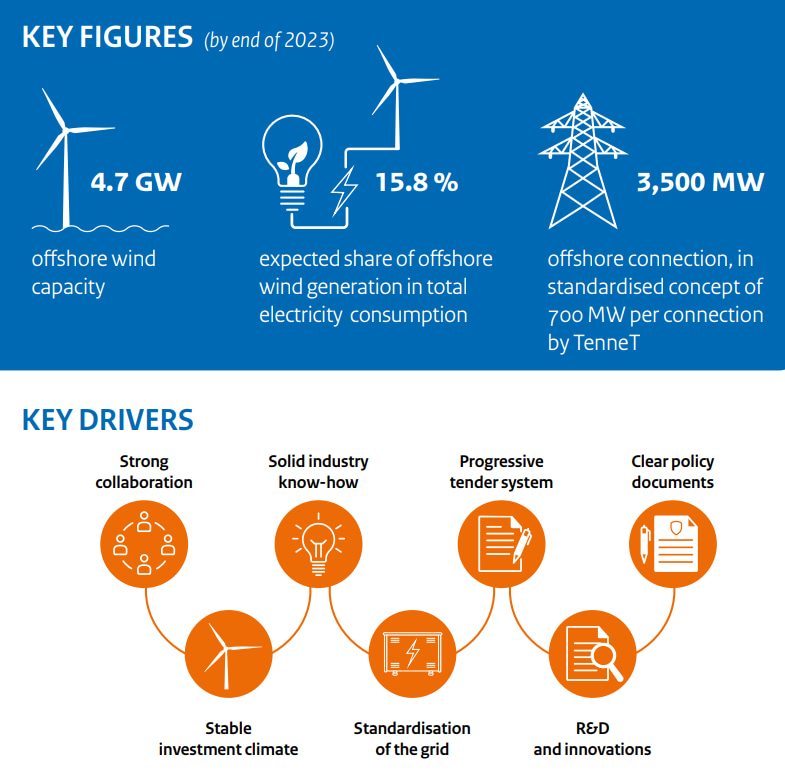The Netherlands will reach, and exceed, the target set in its Offshore Wind Energy Roadmap 2023 by the end of this year. The country’s first offshore wind roadmap, created following the Dutch Energy Agreement signed ten years ago, sets a goal of 4.5 GW of installed capacity by the end of 2023 – and the Netherlands is on its way to having 4.7 GW up and running in the North Sea in December.
The new national offshore wind goal is for 21 GW by 2030, as confirmed in the North Sea Programme 2022-2027. To reach this, a rapid and cost-effective rollout of large-scale projects in the next few years is essential.
“To reach 4.5 gigawatts is a lot since we only started working on building large offshore wind farms in the North Sea from 2017. Initially, we saw a decline in the demand for subsidies and then we saw no demand for subsidies – and that was a real market change,” said Peter Lambooij, Advisor Offshore Wind Energy at the Netherlands Enterprise Agency (RVO), part of the Ministry of Economic Affairs and Climate Policy.
“Offshore wind did not take off in a major way until 2015/2016, when the Dutch government made changes and that has led us to where we are today. Most importantly, we started to be in charge of the site characterisation and also changed elements in our tender systems.”

Image source: RVO
This changed the way the developers saw offshore wind development in the Netherlands, especially because this approach also helped mitigate the risks, lower the costs and create better market conditions, according to Lambooij.
The basis on which the current Dutch approach has been built is competitive tendering with a tender system open to any offshore wind developer who wants to bid for development rights for a specific project site. The system has progressed from how it was designed in the beginning when the main requirements revolved around financial, feasibility and technical criteria.
“Ecology and system integration have now become important parts of our offshore wind tenders. This means that our tender system is also a driver for R&D and innovation and that it pushes both the market and us in the government to always think ahead and be a bit like entrepreneurs ourselves,” Peter Lambooij said.
The Dutch government has a very clear policy and is also very clear on what the requirements are, so there is not a lot of uncertainty from the government’s side and from the legislation point of view, Lambooij pointed out and added that there was also a very stable investment climate in the Netherlands, which contributes to reaching the target(s).
One of the major factors is also that the offshore grid, for which the transmission system operator (TSO) TenneT is responsible, has been standardised.
Furthermore, having an experienced supply chain that transferred the expertise from the offshore oil and gas sector into offshore wind and advanced it there brought an additional boost to the development of offshore wind in the Netherlands, together with the knowledge that comes from the Dutch knowledge institutions, as well as the SMEs from the supply chain.
What also plays an important role is the collaborative environment that RVO has created, which includes the government, investors/developers, the supply chain, and the stakeholders.
RVO has established collaborations with all the market parties, trade organisations, climate organisations and the public. With this collaborative approach in place, there is a constant discussion that helps the country achieve offshore wind targets while ensuring offshore wind farms are being built and operated in a way that benefits the public, the economy and safeguards the environment as much as possible, according to Peter Lambooij.
The 4.7 GW of offshore wind capacity, for which RVO estimates will meet approximately 15.8 per cent of the total current electricity demand in the Netherlands, will be reached once the 759 MW Hollandse Kust Noord offshore wind farm is put into operation at the end of this year.
The share of offshore wind-generated electricity on the Dutch grid is poised to significantly increase over the next decades, with the 2030-2031 target set at 21 GW and the government aiming for 70 GW by 2050.
The targets beyond 2031 will be officially established in the upcoming National Energy System Plan, which will detail the capacities for offshore wind energy in 2035, 2040 and 2050.
RVO will celebrate achieving the target under the 2023 offshore wind roadmap at the Offshore Energy Exhibition & Conference (OEEC) on the 28th and 29th of November in Amsterdam.
“Years ago, we started with a booth at the Offshore Energy Exhibition & Conference and our presence has grown over the years with the development of offshore wind, both in the Netherlands and worldwide. But this year is special. We will be celebrating our successful finalisation of the 2023 offshore wind roadmap at OEEC 2023 in Amsterdam as well, where we will have an overview of what we have accomplished together with the market at our pavilion,” RVO’s Peter Lambooij said.“Offshore wind did not take off in a major way until 2015/2016, when the Dutch government made changes and that has led us to where we are today. Most importantly, we started to be in charge of the site characterisation and also changed elements in our tender systems.”